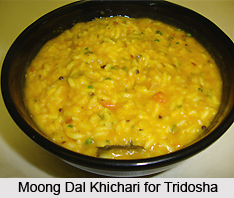 Moong dal khichari is excellent for tridoshic (all the doshas in balance) prakriti. This recipe is the very core of Ayurvedic nutritional healing. It is loaded with nutrition and can heal various diseases. Owing to its ease of digestion and assimilation, it is used in Ayurvedic cleansing therapy. This dish can be consumed by all doshas.
Moong dal khichari is excellent for tridoshic (all the doshas in balance) prakriti. This recipe is the very core of Ayurvedic nutritional healing. It is loaded with nutrition and can heal various diseases. Owing to its ease of digestion and assimilation, it is used in Ayurvedic cleansing therapy. This dish can be consumed by all doshas.
Moong Dal, an important ingredient of this recipe, is one the most cherished foods in Ayurveda. It is tridoshic and is capable of balancing all three doshas. It is very nourishing and relatively easy to digest. The other ingredients of this dish are basmati rice, ginger, cilantro leaves, and black peppercorns to name a few. It is easy to make and can be cooked even at home.
Ingredients of Moong Dal Khichari for Tridosha
•One cup of basmati rice
•One cup of yellow moong dal
•One inch piece of fresh ginger, peeled and finely chopped
•Two tablespoonful of shredded, unsweetened coconut
•A handful of fresh cilantro leaves
•Six cups water
•Ten black peppercorns
•Three bay leaves
•Five whole cloves
•One and a half inch of cinnamon bark
•Three tablespoonful of ghee
Method of Preparing Moong Dal Khichari for Tridosha
•The moong dal and the rice should be soaked in water for at least two hours before cooking.
•Blend ginger, coconut, cilantro and half cup water until it forms a fine liquefied paste.
•Heat a large saucepan on medium flame and add ghee after some time.
•Then put cinnamon, cloves, cardamom, peppercorns and bay leaves. Stir the ingredients for some time till it gives out an aroma.
•Add the liquefied paste along with turmeric and salt. Stir till it turns slightly brown in colour.
•Add the moong dal and the rice in the gravy and mix it well.
•Add the six cups of water cover the saucepan and boil it for nearly five minutes. Reduce the flame and cook by slightly covering the saucepan till the rice and dal softens and mixes well with each other. Do this for nearly half an hour.
•Serve hot.
This scrumptious dish can be eaten both as lunch and dinner. It can be teamed up with mixed-vegetable dish or salad.




















